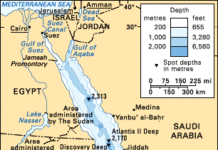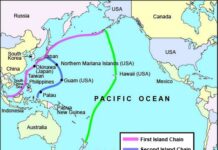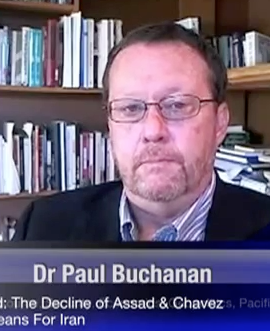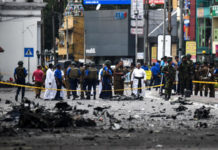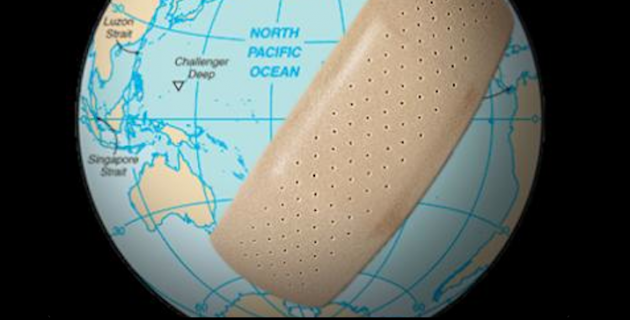Intelligence Analytics: Conceptualizing Foreign Aid as an Instrument of Policy
Analysis – By Dr Paul G. Buchanan.
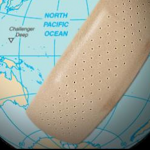 Announcement that the European Union will direct another 19 million Euros on top of the 785 million Euros (NZ$ 1.3 billion) already allocated to climate change adaptation in the Pacific serves as a good reference point for discussion about the use of foreign aid as an instrument of policy.
Announcement that the European Union will direct another 19 million Euros on top of the 785 million Euros (NZ$ 1.3 billion) already allocated to climate change adaptation in the Pacific serves as a good reference point for discussion about the use of foreign aid as an instrument of policy.In general terms, the provision of aid can be considered to be a soft power means of winning friends and influencing people. Whatever the specific project or purpose, all aid can be considered to be “developmental” in the sense that it provides or facilitates the provision of something that local governments or communities cannot do on their own. These can be in the form of services such as professional expertise or health and education campaigns or in the form of concrete deliverables such as infrastructure improvements. They can involve institution and capability building, disaster relief, or humanitarian assistance which may involve the direct transfer of funds from governments, private agents or non-governmental organizations (NGOs) to local implementation agencies. They can involve soft or concessionary loans, direct grants and gifts, and the provision of labor. In all cases, the provision of foreign aid has as an immediate motive improving the relations between donors and hosts, although the background reasons for providing aid often differ and are not confined to promoting friendship between nations.
The literature on foreign aid is voluminous and often highly technical. It will not be reviewed here, nor will conventional categorizations in that literature be addressed. Instead, the object is to generally classify types of aid so as to understand their purpose and explore the consequences of their provision.
Developmental aid can be divided into three types: compensatory, idealistic and strategic.
 Compensatory aid is provided in order to redress past collective injustice or exploitation on the part of the donor. In some cases it is a manifestation of post-colonial angst or idealism on the part of those saddled with the legacy of responsibility for unjust acts committed by their predecessors. In other cases it can be offered by private actors atoning for past exploitation. Although it can be offered for opportunistic, tactical or strategic purposes, it is seen as a form of restorative justice. An example is restoration of wetlands or shorelines by private developers, who belatedly understand that their private gain came at an ecological as well local community expense. Another example is the de-mining and medical services provided by states whose weapons are used in conflict zones.. They may not have been directly involved in the fighting, but they hold a sense of responsibility for the human toll exacted by it.
Compensatory aid is provided in order to redress past collective injustice or exploitation on the part of the donor. In some cases it is a manifestation of post-colonial angst or idealism on the part of those saddled with the legacy of responsibility for unjust acts committed by their predecessors. In other cases it can be offered by private actors atoning for past exploitation. Although it can be offered for opportunistic, tactical or strategic purposes, it is seen as a form of restorative justice. An example is restoration of wetlands or shorelines by private developers, who belatedly understand that their private gain came at an ecological as well local community expense. Another example is the de-mining and medical services provided by states whose weapons are used in conflict zones.. They may not have been directly involved in the fighting, but they hold a sense of responsibility for the human toll exacted by it.
Compensatory aid should not be confused with reparations. Reparations are a monetary settlement between two parties, channeled as a financial transfer from one to the other in the form of direct grant or payment. Reparations are often involuntarily forced upon a defeated party to war, and are rarely given in peacetime. Compensatory aid is given unilaterally and is not part of a negotiated settlement between the donor and donee (although contracts exist with regard to the specific details of provision and implementation). Although it may involve the transfer of funds, the direction of funding and organizational channeling of compensatory aid is more conditioned and targeted than reparations usually are.
Idealistic aid is aid that is provided for altruistic purposes. It can respond to notions of universal justice or in defense of human rights as broadly outlined in the 1948 Universal Declaration of Human Rights and its addenda. It may have an ideological or philosophical basis, such as with classic liberalism or various religious beliefs. Although state actors can adopt idealist positions on the provision of some form of aid, most of the aid provided for altruistic purposes is offered by private actors such as churches and non-governmental agencies like OXFAM and Surgeons without Frontiers. Even here, there can be strategic interests at play: churches may seek converts, NGOs may by pushing for the local adoption of universal codes of conduct, etc.
Strategic aid is aid that is offered in order to advance the geopolitical, private or public interests of the donor. It may have a compensatory or idealistic aspect to it. The differentiation with “pure” compensatory or idealistic aid comes from the primary motive behind its provision, which is not rooted in restorative or idealist logics. Strategic aid is provided to advance the short and long-term interests of the donor, which may be calculated in terms of power, influence, cooperation or mutual gain. State, private sector actors and NGOs all engage in the provision of strategic aid.
The EU offer of aid to Pacific Island Countries (PICs) to help them “adapt” to climate change is an example of compensatory aid given with strategic purposes in mind. Stemming from the 2008 Joint EU-Pacific Islands Forum (PIF) Declaration and 2010 Joint Initiative with the PIF, the EU bases its latest initiative on the belief that climate change is the single greatest threat to PICs. The EU argues that although PICs contribute little to global warming, climate change and sea levels rises due to their relatively low amount of carbon emissions, they suffer disproportionately and immediately the effects of them. Thus the EU compensates for its negative contribution to climate change as a net carbon emitter via foreign aid projects specifically designed to ameliorate the impact of climate change on PICs. In doing so it strengthens EU influence after a period in which it was largely absent as a regional player, thereby balancing or countervailing by non-military means the initiatives of other countries and agencies also seeking to influence the region via economic and diplomatic initiatives. Although the reality may be that climate change is not the greatest threat to PIC welfare, at least over the short term, framing of aid provision in such terms gives it a humanitarian appeal that overshadows the broader strategic interests at play.
An example of strategic aid is provided by the PRCs funding of numerous infrastructure development projects in the PICs during the last 20 years. Run through a network of private and state agencies coordinated by the state capitalist policy directives of a single party authoritarian regime, China’s goodwill initiatives in the South Pacific may have idealistic motivations. They certainly has strategic value, as the promotion of strong diplomatic and economic ties throughout the South Pacific helps the PRC more directly monitor the sea lanes of communication that tie it to the commodity producers and consumers of Australasia and South America. The potentially dual purpose nature of many Chinese-funded and built infrastructure projects such as ports and airports has given rise to suggestions that it will eventually establish military bases in the region as part of an extended “String o Pearls” forward basing strategy. Whether that is true or not is open to debate, but the strategic utility of PRC aid to PICs is not.
The strategic utility of aid can be also seen in the history of USAID in the South Pacific after the Cold War. Once the Berlin Wall fell, the US withdrew most of its USAID offices and significantly downscaled its aid to the PICs. It even cut back on Peace Corps operations in the region (the Peace Corps being a volunteer organization that send US citizens to work on development projects in less-developed countries, with the money for their deployments coming from the federal government and administered through the State Department. In some parts of the world th Peace Corps has been accused on serving as an intelligence collection front for the US). Although Australia and New Zealand continued to supply aid to PICs, downscaling of US aid programs in the South Pacific created a developmental “vacuum” into which stepped the PRC, Taiwan, Japan and other actors willing to supply foreign aid for various developmental projects, often without the accountability rules that came with US, Australian and New Zealand aid. This shift in aid donors helped turn the foreign policy orientation of several PICs, most notably Fiji, in an Asian direction.
Generally speaking, the rules governing the provision of compensatory aid are looser than those governing idealistic aid. That is because the former is a form of redress while the latter is focused on a specific developmental target. The accountability and implementation rules governing strategic aid are a mixed bag. In some case, such as with direct grants to local governments, the rules governing the use of aid donations are quite loose. In other cases, such as with programs that require financial transparency and organizational efficiency as defined by international actors (such as the nation-building efforts of the RAMSI mission in the Solomon Islands), the rules are quite elaborate (although, to be truthful, not always observed). This has led to the unhappy development of a two-tier system of aid provision in the South Pacific whereby efforts to demand more accountability and transparency on the part of some donors are undermined by the spendthrift practices of others.
Cultural practices also impinge on the provision of foreign aid in the South Pacific. Efforts to adapt foreign aid provision to local customary practice have often led to the misuse and misappropriation of funds. Pre-modern traditions of privilege, patronage and patrimonialism often clash with the transparency and accountability requirements of some donors. For example, the Secretary General of the Pacific Island Forum, Tuiloma Neroni Slade, recently thanked a visiting EU delegation in Auckland for their adoption of a “Pacific methodology” for implementation of the climate change adaptation project. The EU has referred to “tailor-made delivery methods” in which delegated cooperation would be considered on a case by case basis so as to reduce aid fragmentation in the region. Slade’s reference to a “Pacific methodology” may or may not be coincident with that objective, but it raises questions as to how local custom and EU implementation objectives will be reconciled in practice.
To this is added the problem of a growing aid bureaucracy throughout the region, much of it staffed by expatriates from donor nations and foreign agencies. With private and public sector backgrounds in “development” issues, aid bureaucrats often enjoy standards of living far superior to the local population and are therefore seen as removed from the actualities of policy implementation in the field. Coupled with local aid bureaucracies in which customary practices of recruitment and distribution prevail, and the downside of foreign aid provision in the South Pacific becomes apparent. Whatever the intentions of the donors, in practice much aid does not achieve the intended developmental targets or goals. Much of that is due to waste and misadministration.
Regardless of the specific nature of the aid provided, provision of foreign aid in the South Pacific has deepened the aid dependence of PICs. In many PICs twenty percent or more of their GDP is made up of foreign aid, which in some cases has contributed to a condition of intractable dependence. Absent universal rules for aid provision negotiated by donors and recipients, to include standardized guidelines for aid provision and timelines for project completion and aid termination, this condition will continue in the future. For some donors that may not be a bad thing, as it provides them with an ongoing source of influence and leverage in local and regional affairs regardless of inefficiencies in aid provision.
Foreign aid is a big part of South Pacific life and as such has strategic implications in its disbursement, to include the motivations for it and the forms in which it is offered. In the measure that it retains strategic utility for extra-regional actors, it will continue to be a large part of the diplomatic and economic discourse of the region, and therefore a focus of contention in the measure that competing donors do not agree on a standard set of rules governing its provision.



